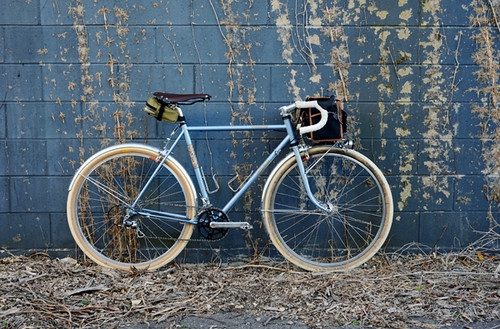
Last summer I test rode and reviewed a Rawland Nordavinden, which I liked very much. At the time I was waiting for a similar frame (a prototype project) to be finished and it was unclear when that would happen. Could be soon, could be in another year, as these things go. In the meantime I kept borrowing bikes to do dirt road rides, which didn't feel right. Soafter giving it some thought, I bought the Nordavinden frame for personal use and built it up as an interim bike, with components destined for my own frame. Long story short, but for now the Rawland remains.I got used to it, I like it and can't bring myself to dismantle it.
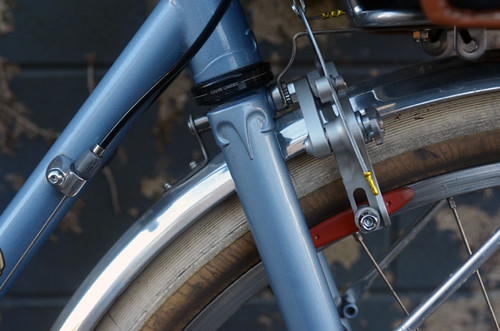
The frameset is the same one described earlier, so I won't go into detail again. But quick summary: It is steel, with thin wall standard diameter tubing and low trail geometry, made to fit 650Bx42mm tires and to accommodate sidepull or centerpull brakes. The way I set up this bike is considerably different from the demo model I tried last summer, so I'd like to share my impressions of this version.

Rawland owners have their own newsgroup called rCOG, which I browse with interest. One common theme I've noticed there is that they like to keep the weight of their builds down. I did this to some extent as well, but didn't take it as far as one could. For instance, I went for lightweight wheels, but didn't fret as much over the other components. Still, the bike - before fenders, front rack or handlebar bag, but including saddle, pedals, bottle cages and bar tape - weighed a respectable 22lb, according to Harris Cyclery's scale. Once the final accessories were added, the weight rose to 25lb. That is not bad for a bike of its type, though it's possible to do better (for a price).
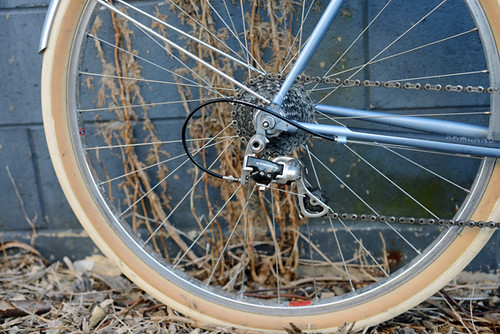
The wheels were built around Pacenti PL23 rims, with a Schmidt SON dynohub in the front and a White Industries rear hub, with a Campagnolo road cassette. The tires are the 650Bx42mm Grand Bois Hetres. Some have pointed out that this bike looks like it has fatter tires than the one I tried last summer, but that's only because these are cream and the others were black. White tires tend to look larger; it's an optical illusion.
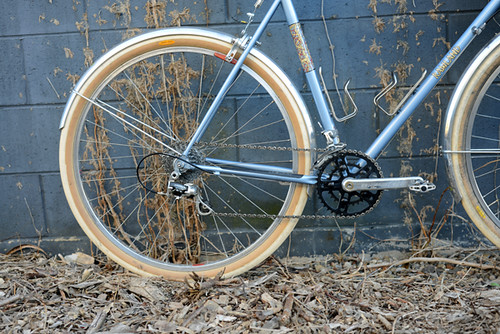
The drivetrain is a hybrid of older Campagnolo Chorus (not sure what year, but it was when Chorus was still a 10-speed group), and a White Industries VBC road double. The goal here was to achieve super low gearing without weighing down the rear wheel with a mountain cassette, as well as allowing me to use my favourite shifters. As far as smoothness of operation and reliability, the setup works okay, but I would not go so far as to recommend it (or any other hybrid drivetrain I've tried to date) to others. More on this in a later post; it could be a bit of a rant.

But as far as gearing, the setup is heavenly. I have 42/28t rings on the crankset, and a 12-29t cassette in the rear. On pavement, I mostly use the big ring, and it provides a decent range. On dirt, I switch to small and it also provides a decent range. Having a sub 1:1 gear is wonderful. I tend to pedal at a high cadence, so climbing hills on an overgeared bike is a sure way to dampen my enjoyment of a ride. With the low gearing here, my legs always feel good on climbs; I feel like I could go anywhere.

The brakes are Paul Racers, and I reviewed them here. Honjo fluted fenders.

When riding on dirt and gravel, I prefer the Selle Anatomica saddle for the extra bit of give it provides. I've reviewed SA saddles before (here and here), but might need to post an update.

In the front I have a Nitto Mark's rack and a modified VO Campagne handlebar bag, which I use as a camera bag. The headlight is a Schmidt Edelux, on a DIY bracket. I have not installed a dynamo tail light yet, but when I do it will be the Spanniga Pixeo.
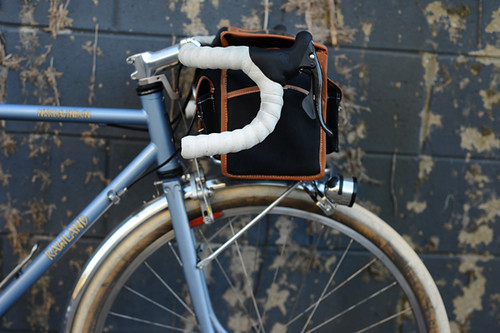
Cane Creek headset, Velo Orange stem, Grand Bois Maes handlebars, Cinelli cork tape. In retrospect, I think the white tape was an aesthetic mistake on this bike, but I'll keep it while it lasts.
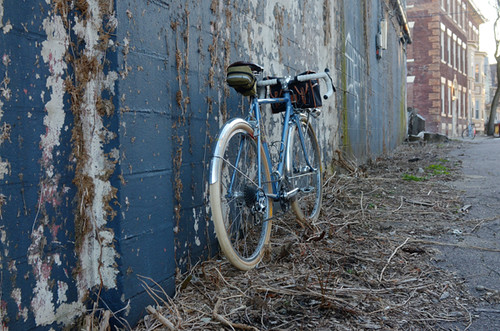
Not clearly pictured here are my Crankbrothers Candy pedals, and King bottle cages (made by these guys), with Lezyne mini-pump attached. When I ride this bike, I typically keep tools in the saddle wedge and camera stuff in the handlebar bag. If I were doing a multi-day trip, I would substitute a large saddlebag for the wedge. I do not plan to install a rear rack.

[image by Pamela Blalock]
The role of this bicycle seems to confuse a lot of people. I've been repeatedly asked why I did not ridelast weekend's Permanent on it, since it's the prototypical "rando bike." But it's not a rando bike, at least not to me. I prefer to do paved rides - be they short or long - on my lightweight skinny-tire roadbike. On pavement, my roadbike is faster and feels better; I get less tired and find it easier to keep up with others. This may not be the case for everyone, but it is for me. However on dirt and gravel, this dynamic changes and a fat tire bike feels both more comfortable and more efficient. I also find the Rawland's distinct handling to be helpful on twisty unpaved rides, which in turn allows me to ride more confidently, relax and enjoy myself more.
So the Rawland (and any similar bike it might eventually be replaced with) is for unpaved riding. It is also a "camera bike," for long rides where I go exploring and photo-scouting. These two use case scenarios sometimes, though not always, overlap.The frame feels springy, but not noodly.A full handlebar bag does not seem to impact handling in any noticeable way, but the bike also handles just fine without it, as well as with weight on the rear only. In general (another rant-inducing topic best saved for another post), I am coming to the conclusion that handlebar bag setups are unnecessarily bulky and troublesome. I would not go this route, if it weren't for my desire to carry heavy cameras on the front of the bike. That said, I enjoy my setup, despite the trouble it took to install everything to my satisfaction and the extra weight.
I've now had the Rawland since September, though I did not ride it for a period from January till late March due to snow. My favourite things about it are the handling, and that it allows me to carry my big cameras in the front. It is a fine bike and a fun bike - though I'll be remiss not to note that others who try it don't always like it; the phrase "hinged in the middle" is used. It seems the low trail thing is really a matter of taste (and/or of getting used to).
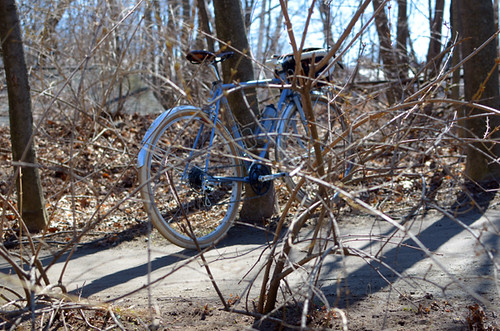
With unpaved rides becoming more popular than ever, lots of cyclists are looking for appropriate bikes and the Rawland is a great option. In addition to the Nordavinden, there is now also the Stag model, which is made forcantilever or v-brakes, and for 650B wheels in all sizes (whereas only the smaller Nordavinden comes in 650B). And for an entirely different take on bikes for unpaved riding, watch for an upcoming review of the Honey Cyclocross bike.




 Small and sensitive to climb technical ground in
Small and sensitive to climb technical ground in So some where in between we should be able to come up with a double boot that is both warm and sensitive. But it isn't as easy as you might first expect.
So some where in between we should be able to come up with a double boot that is both warm and sensitive. But it isn't as easy as you might first expect. This isthe best example I can easily show you of what I am trying to convey on boot lasts. The Koflach Arctisis over size and bath tub shaped. The TLT 5 is very anatomical lasted. Even with just a ski boot sole the TLT5 is easier to climb in for feel.
This isthe best example I can easily show you of what I am trying to convey on boot lasts. The Koflach Arctisis over size and bath tub shaped. The TLT 5 is very anatomical lasted. Even with just a ski boot sole the TLT5 is easier to climb in for feel. 

 Current Koflach "Guardian"But actually the last gen Ultra shell, which was/is an excellent boot.
Current Koflach "Guardian"But actually the last gen Ultra shell, which was/is an excellent boot.

 double click this one to see them all
double click this one to see them all























